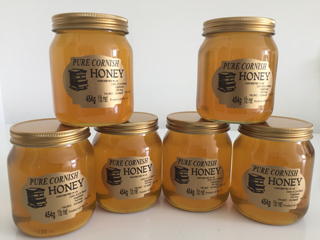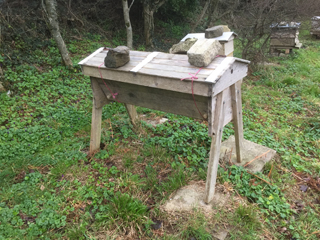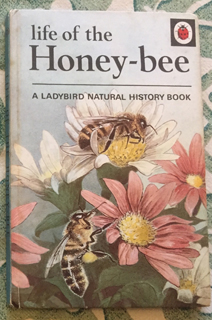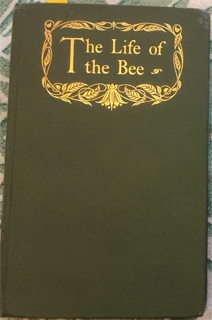 As 2018 draws to a close and the days are getting longer, we can look back and see what was good and what was not so good. Hopefully, there will be more good things than not so good to recall and we can look forward to a New Year which always holds even greater promise of good things to come. This is true of beekeeping, as well as everything else in our lives. The coming season is going to be the best yet (every beekeepers’ belief at the end of a poor honey harvest)!
As 2018 draws to a close and the days are getting longer, we can look back and see what was good and what was not so good. Hopefully, there will be more good things than not so good to recall and we can look forward to a New Year which always holds even greater promise of good things to come. This is true of beekeeping, as well as everything else in our lives. The coming season is going to be the best yet (every beekeepers’ belief at the end of a poor honey harvest)!
It is the time of year, though, when we beekeepers should go out to our hives and “heft” them, that is, lift one side gently off the ground, then go round to the other side and lift that gently off the ground as well – only about 1cm or so, we’re not trying to tip them over. If the hive feels as if it’s “nailed” to the ground, we know there are enough stores in the brood box to see the bees right for a while yet.
 However, if we end up virtually tipping the hive over by inadvertently applying too much “lift” to the heft, and it feels light, then the bees are likely to be short of stores and we need to do something – quickly! I have done this to my hives and in the main they are adequately provisioned. But as ever, there are one or two hives which are low on stores, either having eaten everything they had brought in or not having brought in as much as other colonies in the first place.
However, if we end up virtually tipping the hive over by inadvertently applying too much “lift” to the heft, and it feels light, then the bees are likely to be short of stores and we need to do something – quickly! I have done this to my hives and in the main they are adequately provisioned. But as ever, there are one or two hives which are low on stores, either having eaten everything they had brought in or not having brought in as much as other colonies in the first place.
The former could be down to the degree of Italianisation (is that a word? If not, it should be!) of the queen, because the Italian bees are notorious for not being frugal with their stores – “Hey, look at all this food! Let’s have a party!”. The latter could be because the colony is smaller and had a smaller foraging force available to gather the nectar and pollen from the ivy and asters at the end of the season.
 Either way, they are short of food and need topping up, so I will make some fondant for them and either place it over the feed-hole in the crown-board or directly on the frames in contact with the bee cluster, so that they don’t have to break their cluster to reach it. If bees break their cluster, some of them might drop below their survival temperature of 7 or 8 degrees and fall to the hive floor and die, and we don’t want that.
Either way, they are short of food and need topping up, so I will make some fondant for them and either place it over the feed-hole in the crown-board or directly on the frames in contact with the bee cluster, so that they don’t have to break their cluster to reach it. If bees break their cluster, some of them might drop below their survival temperature of 7 or 8 degrees and fall to the hive floor and die, and we don’t want that.
My hives came off virtually unscathed during the extremely high winds we had recently. Rooves stayed in place on all hives but strangely, the massive, really weighty, coffin-shaped top bar hive (which fortunately was empty of bees) was totally blown over! I have lost the roof of this hive on a fairly regular basis – despite its weight – and lost as in it being blown away from the hive. I have therefore tried tying down the roof to the body (the cord breaks), placing large breeze blocks on the sloping roof sides (the stones get dislodged and then there is nothing left to hold it down) – nothing I have done so far seems to do the trick.
 This Spring, though, I will reposition the hive squarely on its four paving slabs and drill eye-bolts into each one so that I can tie the hive to the ground with ropes going over the top of the hive from and to the eye-bolts on each side. We are so exposed where we are – we get the wind from every direction – and the hives get everything bar the North wind (they are backed up against an East-West hedge). I intend to re-stock the hive again this Spring, so I must find a way of keeping it secure once and for all and this approach should do it – I hope!
This Spring, though, I will reposition the hive squarely on its four paving slabs and drill eye-bolts into each one so that I can tie the hive to the ground with ropes going over the top of the hive from and to the eye-bolts on each side. We are so exposed where we are – we get the wind from every direction – and the hives get everything bar the North wind (they are backed up against an East-West hedge). I intend to re-stock the hive again this Spring, so I must find a way of keeping it secure once and for all and this approach should do it – I hope!
Christmas is a time of giving and, yet again, I was fortunate enough to receive two bee books amongst my various presents. The first is a classic Ladybird Natural History book, “The Life of the Honey-bee”, published in 1969 and costing 2/6d. It is simple yet accurate and covers most of the main topics of study for potential new beekeepers. My students wouldn’t go far wrong if they used this as the basis for their introduction to the craft – but don’t tell them that! What it lacks in detail it makes up for in accessibility.
 Everybody should read it, whether or not they intend to become beekeepers. The other book is “The Life of the Bee” by Maeterlinck, published in 1901. This too covers all the aspects of honey bees that a potential beekeeper should know (though some facts have been updated since then, thanks to developments in physiological and scientific studies). It also is more florid in its use of the English language and goes into a lot more depth in the various topics covered. Both books are a joy to read, so I am well-placed for the next week or so, before my Winter/Spring courses launch in January, to get an improved grounding in my subject!
Everybody should read it, whether or not they intend to become beekeepers. The other book is “The Life of the Bee” by Maeterlinck, published in 1901. This too covers all the aspects of honey bees that a potential beekeeper should know (though some facts have been updated since then, thanks to developments in physiological and scientific studies). It also is more florid in its use of the English language and goes into a lot more depth in the various topics covered. Both books are a joy to read, so I am well-placed for the next week or so, before my Winter/Spring courses launch in January, to get an improved grounding in my subject!
December is a quiet time for beekeepers and beekeeping so I’ll end my report at this point and wish you all a Happy and Healthy New Year and look forward to writing about my bees again in 2019.
Colin Rees 01872 501313 colinbeeman@aol.com 07939 971104

The very mild December weather has been interesting in terms of insects. I have seen quite a few bumble bees out and about, and the Tregassick wild honeybee colony has also been noticeably active. I feel concerned that this unseasonable activity will also lead to depleted winter stocks of honey, since there can’t be much wild food about right now.